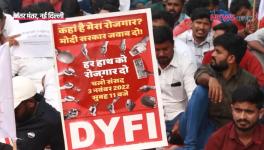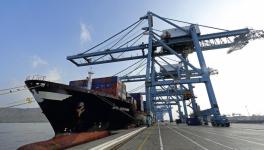An Impending Macroeconomic Crisis in India
Deepak Nayyar, former Vice-Chancellor at the University of Delhi, spoke at a seminar on “Economy in Crisis” organized by Centre for Policy Analysis, New Delhi. He said that macroeconomic crisis in India have been triggered by a fragile balance of payments situation, and the answer lies in not only cutting expenditure, but also increasing income. Nayyar said that the present situation is just as bad as that in 1991. Increase in growth has failed to translate into an increase in employment. Crisis in social infrastructure such as education and health run deep, and India hasn't used industrialization to mobilize its human resource as yet. To address the crisis, there is a need for pro-active engagement of the government, he said.
Transcript:
Deepak Nayyar: In a medium term perspective, there are what I describe as the persistent yet mounting crisis. There is jobless growth, there is persistent poverty, there is rising inequality. And in a long term view, there are quiet almost silent crisis of the economy in India, in agriculture, in infrastructre, in education and now, I believe, in industrialisation because we are witnessing the beginnings of the industrialisation in India. Now, the interesting thing is that, just as the crisis in the economy is interwoven with the politics in polity and society which has been spoken about. The crisis in the economy that straddle different time horizons are closely interconnected. And it is not as if we have to address each crisis in its respective time horizon; we have to address each and every crisis here and now because the period in which they will resolve themselves are much longer than we we think they are. Now first and very briefly, I want to say simply to set the records that there is an impending macro economic crisis. We cannot wish it away. Theory and history both suggest that macro economic crises are triggered almost inevitably by unmanageable balance of payments situations. And therefore, the external sector is the proverbial Achilles heel of an economy in crisis. It precipitates in different forms - plummeting exchange rates, run on the currency, runaway inflation, capital flight and so on. It is often triggered by the external sector and we look at that reality, the balance of payment situation in India is indeed fragile. In 2012-13, the balance of trade deficit, the difference between merchandise imports and exports was 10% of GDP. 200 billion dollars in a GDP of 2 trillion. Ten percent. The highest it has ever been, the highest in any developing or emerging economy in the present conjecture. Inspite of the benefit of remittances at 75 billion last year, and software exports were 70 billion last year which financed the state deficit, the current account deficit is still close to 4% of GDP. And this morning papers report that in the first quarter of the current financil year, it is 4.9% of GDP. Now, we cannot wish away this reality; we have to borrow that much abroad and get that capital first upto 5% of GDP to sustain this. Now, the pattern of financing of this is really unsustainable because it has relied in the past on non-debt creating capital flows but last year Indian firms invested as much abroad as foreign firms invested in India so net FDI was zero. Portfolio investment in the first half of this year, the outflows have been much greater than the inflows. The problem is a) in the size of the deficit and b) in the pattern of financing, because it relies on volatile capital flows. Now, when you embrace global finance which such enthusiasm, you are bound to suffer when there are ebbs and when there are flows and this is no strategy of financing a deficit. Nobody knows more about this than my former colleague and the present chairman - the dangers of living with the ebbs and flows of global finance. But the real problem of course is… you know, I was surprised that Bimal thought there was no crisis. I believe the underlying fundamentals are a cause for worry. There is the persistent inflation that Prem Jha has talked about. There is a balance of trade deficit that is much too large. China has a trade surplus of 8% of GDP. Brazil has a trade deficit of 2% of GDP. Despite the blessing of software exports and remittance inflows, we have a current account deficit that is much large by any standard and certainly unsustainable with the pattern of financing we have chosen to adopt. Of course, there are underlying macro economic imbalances that it does represent a situation where the income of the economy falls short of its expenditure, where investment of the economy exceed its savings and these are reflected in the current account deficit. The answer then was at the beginning, does not lie in cutting the expenditure alone to adjust, we have to increase the income too. The answer lies not only in using foreign capital in finance investment or cutting investment, it lies in raising savings. There are comparisons to be made with 1991 there are similarities and differences but in many ways it is a situation that is bad if not worse. The elections to come later this year and early next year promise to make this task of managing the crisis more difficult than you might think in the first instance. Now, having said that, let me turn to what I believe are India's real crises. This is something that may or may not come. If it comes, it will have nasty consequences; it could be managed with wisdom and dexterity.
You might well ask the question, growth for whom? There are three dimensions, three manifestations of this problem. First, that - increases in output reflected in growth have not been reflected in increases in employment. Employment elasticities have, which are sort of, you know, proportionate increase in output - employment divided by proportionate increase in output - which was something like 0.6, 0.7 until the late 70s have in the last five years collapsed to near zero, both in agriculture and in manufacturing. And I believe this is the biggest failure of the economy in the era of markets and globalisation because employment is the only institutional mechanism that can mediate between economic growth and social development. That, it is no good for government to speak of inclusive growth in the form of transfer payments or in the form of popular schemes. It is about creating employment. The reason why these high rates of growth have not been translated into a corresponding reduction in poverty, which there were by the way in the 1970s, 1980s for what it is worth, is because increments in output have been distributed very unequally. High rates of growth have been associated with rising inequality so that poverty reduction, although it is there, it is simply now commensurate. We can debate on numbers on poverty, but the real issue is that there are two poverty lines. The critical minimum, what was Arjun Sengupta's 12 Rupees per capita per day in 2004 prices and something just above which provides not just nutrition but healthcare, education, shelter. Now, the proportion of people between the two poverty lines in India is as much as 40 percent of our population. Half the world's poor, below 2 dollar per day, live in India. Just as we are seeing evidence of growing inequality, we can see it in the distribution of consumption expenditure that underestimates equality. We can see it in the distribution of national income between wages and profits. We can see it in the emergence of the super-rich and the ultra-rich, in terms of the share of the richest one percent in the national income which is now estimated to be 15% in 2008 in India. Let me now turn and in response to what the chairman said at the outset, let's think about the solutions, and I think if we are going to address these persistent embarking crisis in India, employment must become the focus of the macro economic policies. Governors of the central banks and their performance should be judged not on rates of inflation. Finance Minister should not be judged on rates of inflation or fiscal balances but they should be judged in terms of what's happening to employment. That was the principle macro economic objective in the past. Very briefly, in the last part of what I have to talk about, let me turn to the quiet, almost silent crisis of the Indian economy. Now, I must say I was surprised and somewhat depressed to hear T.N. Ninan whom I respect greatly say that there is no crisis in Indian agriculture. And that is, in a sense, the tragedy of our times. There is a crisis and yet there is so little cognition of it in the public discourse. To the pink pages of our newspapers, it is farmers suicide occasionally, it is the Maoist problem occasionally, often portrayed as law and order problems. Now, these are symptoms of a much deeper malaise. And, Indira Gandhi for all her flaws and works, recognised long time ago early in her rein that there was a deep crisis in Indian agriculture which was sought to be addressed. But, the present dispensation seems to think that the agriculture sector does not exist, or if it exists it does not matter. The reality is that now about 14% of GDP comes from the agricultural sector. But the agriculture sector still employs directly or indirectly more than 2/3rds of our population. So GDP per capita in agriculture is so much lower than the non agricultural sector. What is more, people in the agriculture sector have almost no social opportunities. So that, it's not the share of output it's their share of possible increments in output that is very small. Infrastructure, you know, there is a problem that we have with physical infrastructure - power, roads, transport, ports, communication; there is a problem that we have social infrastructure - education, healthcare, sanitation, even drinking water. Now, if we compare expenditure on physical infrastructure and on social infrastructure as a proportion of GDP in India, it is amongst the lowest in the world. Some sub-Saharan African countries have higher proportions allocated admittedly of lower GDP to that. Now, the ideological belief in the magic of markets has led to premature withdrawal of the state from public investment in infrastructure. The private investment, whether domestic or foreign, has simply not been forthcoming. And the public-private-partnership seem to be a figment of Planning Commission's imagination. Nothing real has emerged but we cannot contemplate a world in India either of economic growth or of human development unless we address this problem of infrastructure. Education, I have spent my life time in it. The education crisis runs deep.There is excellence in islands, but it does not add upto a continent of excellence. In two sentences, I think what we have in terms of educational opportunities is simply not enough. And even what we have is not good enough. Whether we look at primary education, secondary education, vocational education, higher education, professional education - every domain. Now, this has been written about, this has been thought about, there are blue prints galore but for the past ten years, the government has done precious little but rent-seeking and state patronage in the world of education. And, last but not least, my quiet crisis in the economy and I will stop chairman with this, is about industrialisation. There was this morning some mention of it by N.K. Singh that this is a crisis. Now, you know, the founding for this republic, created the initial conditions and laid the essential foundations for industrialisation. Essentially, the Nehruvian view of the world. But, whether it was infrastructure or capital growth, science, technology, government support, it unleashed an enormous potential for industrialisation and in the early 1970s and in the early 1980s even before liberalisation began, we saw some of the benefits of this investment - in terms of learning to industrialise. But, what we have witnessed is 1990 is a cause for concern. In 1990, the share of manufacturing in total output per GDP was close to 18%. In 2010, it's 14%. India desperately needs to industrialise to mobilise its most abundant resource - people through employment creation. The entrepreneurship exists, the skills exist. Manufacturing good driven productivity increase else where in economy, it would lead to spill overs, linkages, externalities. Above all, it would enable India to use its low wages to compete in world markets. It is where our comparative advantage lies and it would also unleash India's enormous potential in spite of the world of cronysm that we live in, in terms of managerial capabilities and technological capabilities. The tragedy is that we have let it go. You know, I said this and I stand corrected that we in 2013 we imported 5 billion dollars worth of mobile phones. We are the largest growing and largest market for mobile telephony in the world. So economies of scale are there for taking and yet the best we do is assembling. Our imports of consumer electronics and components in 2013 was 40 billion US dollars. It's not rocket science. Import substitution is possible. Smaller countries, who came later in industrialisation than we did, are in this business. But this will not happen with the magic of markets. And, once again in response to the Chairman's question, I think it is time to develop a strategic plan for infrastructure in India, to develop a strategic plan for what is to be done in agriculture and after all the green revolution came from such strategic thinking. It had many other adverse consequences but it had many positive consequences too. Its time to plan for the spread of education in society because there will be no demographic dividend to reap unless we address this question and create capabilities amongst our young people. And last not but least, the de- industrialisation will proceed on this course unless we evolve a strategic industrial policy which is combined with a strategic trade policy and a strategic technology policy. None of this is going to happen on its own. It is certainly not going to happen if it is left to the market place, which is the ideology of our times. All of this is going to require pro-active engagement of the government in every sphere I have mentioned. Therefore, if we have to address the economy and its crisis, we are going to have address the politics and its crisis, because politics will remain in command, but I focus my comment on the economy. Thank you.
Get the latest reports & analysis with people's perspective on Protests, movements & deep analytical videos, discussions of the current affairs in your Telegram app. Subscribe to NewsClick's Telegram channel & get Real-Time updates on stories, as they get published on our website.
























